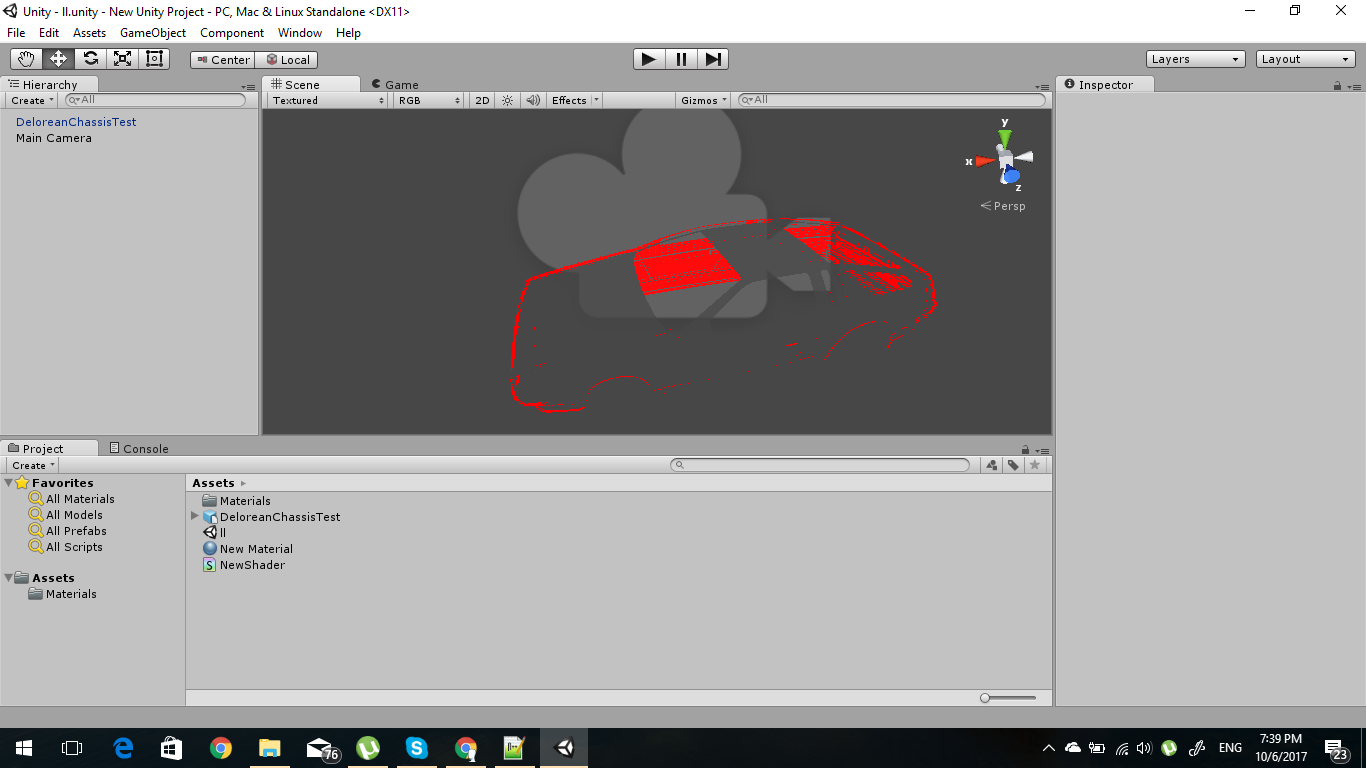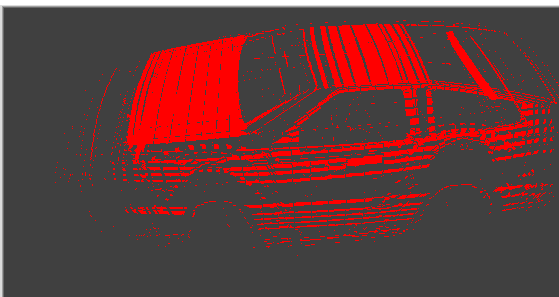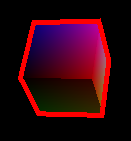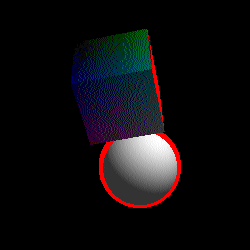I assume single complex 3D mesh. I would do this with 2 pass rendering:
clear screen
let use (0,0,0) as clear color.
render mesh
disable depth output,test (or clear it afterwards). Do not use shading fill just with some predefined color for example (1,1,1) Lets do this for simple cube:
![1st pass]()
read the frame buffer and use it as a texture
So either use FBO and render to texture for #1,#2 or use glReadPixels instead and load it as some texture back to GPU (I know it slower but works also on Intel). For more info see both answers in here:
clear screen with background color
render
so either render GL_QUAD covering whole screen or render your mesh with shading and what ever you want. You need to pass also the texture from previous step into GLSL.
In fragment render as usual ... but at the end also add this:
Scan all texels around current fragment screen position up to distance equal to outline thickness in the texture from previous step. If any black pixel found in it override outputted color with your outline color. You can even modulate it with the smallest distance to black color.
This is very similar to this:
but much simpler. Here result:
![2nd pass]()
I took this example Analysis of a shader in VR of mine and converted it to this:
Fragment:
// Fragment
#version 400 core
#extension GL_ARB_explicit_uniform_location : enable
layout(location =64) uniform vec3 lt_pnt_pos;// point light source position [GCS]
layout(location =67) uniform vec3 lt_pnt_col;// point light source color&strength
layout(location =70) uniform vec3 lt_amb_col;// ambient light source color&strength
in vec3 LCS_pos; // fragment position [LCS]
in vec3 pixel_pos; // fragment position [GCS]
in vec3 pixel_col; // fragment surface color
in vec3 pixel_nor; // fragment surface normal [GCS]
out vec4 col;
// outline
uniform sampler2D txr; // texture from previous pass
uniform int thickness; // [pixels] outline thickness
uniform float xs,ys; // [pixels] texture/screen resolution
void main()
{
// standard rendering
float li;
vec3 c,lt_dir;
lt_dir=normalize(lt_pnt_pos-pixel_pos); // vector from fragment to point light source in [GCS]
li=dot(pixel_nor,lt_dir);
if (li<0.0) li=0.0;
c=pixel_col*(lt_amb_col+(lt_pnt_col*li));
// outline effect
if (thickness>0) // thickness effect in second pass
{
int i,j,r=thickness;
float xx,yy,rr,x,y,dx,dy;
dx=1.0/xs; // texel size
dy=1.0/ys;
x=gl_FragCoord.x*dx;
y=gl_FragCoord.y*dy;
rr=thickness*thickness;
for (yy=y-(float(thickness)*dy),i=-r;i<=r;i++,yy+=dy)
for (xx=x-(float(thickness)*dx),j=-r;j<=r;j++,xx+=dx)
if ((i*i)+(j*j)<=rr)
if ((texture(txr,vec2(xx,yy)).r)<0.01)
{
c=vec3(1.0,0.0,0.0); // outline color
i=r+r+1;
j=r+r+1;
break;
}
}
else c=vec3(1.0,1.0,1.0); // render with white in first pass
// output color
col=vec4(c,1.0);
}
The Vertex shader is without change:
// Vertex
#version 400 core
#extension GL_ARB_explicit_uniform_location : enable
layout(location = 0) in vec3 pos;
layout(location = 2) in vec3 nor;
layout(location = 3) in vec3 col;
layout(location = 0) uniform mat4 m_model; // model matrix
layout(location =16) uniform mat4 m_normal; // model matrix with origin=(0,0,0)
layout(location =32) uniform mat4 m_view; // inverse of camera matrix
layout(location =48) uniform mat4 m_proj; // projection matrix
out vec3 LCS_pos; // fragment position [LCS]
out vec3 pixel_pos; // fragment position [GCS]
out vec3 pixel_col; // fragment surface color
out vec3 pixel_nor; // fragment surface normal [GCS]
void main()
{
LCS_pos=pos;
pixel_col=col;
pixel_pos=(m_model*vec4(pos,1)).xyz;
pixel_nor=(m_normal*vec4(nor,1)).xyz;
gl_Position=m_proj*m_view*m_model*vec4(pos,1);
}
And CPU side code looks like this:
//---------------------------------------------------------------------------
#include <vcl.h>
#pragma hdrstop
#include "Unit1.h"
#include "gl_simple.h"
//---------------------------------------------------------------------------
#pragma package(smart_init)
#pragma resource "*.dfm"
TForm1 *Form1;
//---------------------------------------------------------------------------
GLfloat lt_pnt_pos[3]={+2.5,+2.5,+2.5};
GLfloat lt_pnt_col[3]={0.8,0.8,0.8};
GLfloat lt_amb_col[3]={0.2,0.2,0.2};
GLuint txrid=0;
GLfloat animt=0.0;
//---------------------------------------------------------------------------
// https://mcmap.net/q/906101/-silhouette-outlined-shader/2521214
//---------------------------------------------------------------------------
void gl_draw()
{
// load values into shader
GLint i,id;
GLfloat m[16];
glUseProgram(prog_id);
GLfloat x,y,z,d=0.25;
id=glGetUniformLocation(prog_id,"txr"); glUniform1i(id,0);
id=glGetUniformLocation(prog_id,"xs"); glUniform1f(id,xs);
id=glGetUniformLocation(prog_id,"ys"); glUniform1f(id,ys);
id=64; glUniform3fv(id,1,lt_pnt_pos);
id=67; glUniform3fv(id,1,lt_pnt_col);
id=70; glUniform3fv(id,1,lt_amb_col);
glGetFloatv(GL_MODELVIEW_MATRIX,m);
id=0; glUniformMatrix4fv(id,1,GL_FALSE,m);
m[12]=0.0; m[13]=0.0; m[14]=0.0;
id=16; glUniformMatrix4fv(id,1,GL_FALSE,m);
for (i=0;i<16;i++) m[i]=0.0; m[0]=1.0; m[5]=1.0; m[10]=1.0; m[15]=1.0;
id=32; glUniformMatrix4fv(id,1,GL_FALSE,m);
glGetFloatv(GL_PROJECTION_MATRIX,m);
id=48; glUniformMatrix4fv(id,1,GL_FALSE,m);
// draw VAO cube (no outline)
id=glGetUniformLocation(prog_id,"thickness"); glUniform1i(id,0);
glClear(GL_COLOR_BUFFER_BIT | GL_DEPTH_BUFFER_BIT);
vao_draw(); // render cube
// copy frame buffer to CPU memory and than back to GPU as Texture
BYTE *map=new BYTE[xs*ys*4];
glReadPixels(0,0,xs,ys,GL_RGB,GL_UNSIGNED_BYTE,map); // framebuffer -> map[]
glEnable(GL_TEXTURE_2D);
glBindTexture(GL_TEXTURE_2D,txrid);
glTexImage2D(GL_TEXTURE_2D, 0, GL_RGB, xs, ys, 0, GL_RGB, GL_UNSIGNED_BYTE, map); // map[] -> texture txrid
delete[] map;
// draw VAO cube (outline)
id=glGetUniformLocation(prog_id,"thickness"); glUniform1i(id,5);
glClear(GL_COLOR_BUFFER_BIT | GL_DEPTH_BUFFER_BIT);
vao_draw(); // render cube
glDisable(GL_TEXTURE_2D);
// turn of shader
glUseProgram(0);
// rotate the cube to see animation
glMatrixMode(GL_MODELVIEW);
// glRotatef(1.0,0.0,1.0,0.0);
// glRotatef(1.0,1.0,0.0,0.0);
glFlush();
SwapBuffers(hdc);
}
//---------------------------------------------------------------------------
__fastcall TForm1::TForm1(TComponent* Owner):TForm(Owner)
{
gl_init(Handle);
glGenTextures(1,&txrid);
glEnable(GL_TEXTURE_2D);
glBindTexture(GL_TEXTURE_2D,txrid);
glPixelStorei(GL_UNPACK_ALIGNMENT, 4);
glTexParameteri(GL_TEXTURE_2D, GL_TEXTURE_WRAP_S,GL_CLAMP_TO_EDGE);
glTexParameteri(GL_TEXTURE_2D, GL_TEXTURE_WRAP_T,GL_CLAMP_TO_EDGE);
glTexParameteri(GL_TEXTURE_2D, GL_TEXTURE_MAG_FILTER,GL_NEAREST);
glTexParameteri(GL_TEXTURE_2D, GL_TEXTURE_MIN_FILTER,GL_NEAREST);
glTexEnvf(GL_TEXTURE_ENV, GL_TEXTURE_ENV_MODE,GL_COPY);
glDisable(GL_TEXTURE_2D);
int hnd,siz; char vertex[4096],fragment[4096];
hnd=FileOpen("normal_shading.glsl_vert",fmOpenRead); siz=FileSeek(hnd,0,2); FileSeek(hnd,0,0); FileRead(hnd,vertex ,siz); vertex [siz]=0; FileClose(hnd);
hnd=FileOpen("normal_shading.glsl_frag",fmOpenRead); siz=FileSeek(hnd,0,2); FileSeek(hnd,0,0); FileRead(hnd,fragment,siz); fragment[siz]=0; FileClose(hnd);
glsl_init(vertex,fragment);
// hnd=FileCreate("GLSL.txt"); FileWrite(hnd,glsl_log,glsl_logs); FileClose(hnd);
int i0,i;
mm_log->Lines->Clear();
for (i=i0=0;i<glsl_logs;i++)
if ((glsl_log[i]==13)||(glsl_log[i]==10))
{
glsl_log[i]=0;
mm_log->Lines->Add(glsl_log+i0);
glsl_log[i]=13;
for (;((glsl_log[i]==13)||(glsl_log[i]==10))&&(i<glsl_logs);i++);
i0=i;
}
if (i0<glsl_logs) mm_log->Lines->Add(glsl_log+i0);
vao_init();
}
//---------------------------------------------------------------------------
void __fastcall TForm1::FormDestroy(TObject *Sender)
{
glDeleteTextures(1,&txrid);
gl_exit();
glsl_exit();
vao_exit();
}
//---------------------------------------------------------------------------
void __fastcall TForm1::FormResize(TObject *Sender)
{
gl_resize(ClientWidth,ClientHeight-mm_log->Height);
glMatrixMode(GL_PROJECTION);
glTranslatef(0,0,-15.0);
glMatrixMode(GL_MODELVIEW);
glRotatef(-15.0,0.0,1.0,0.0);
glRotatef(-125.0,1.0,0.0,0.0);
}
//---------------------------------------------------------------------------
void __fastcall TForm1::FormPaint(TObject *Sender)
{
gl_draw();
}
//---------------------------------------------------------------------------
void __fastcall TForm1::Timer1Timer(TObject *Sender)
{
gl_draw();
animt+=0.02; if (animt>1.5) animt=-0.5;
Caption=animt;
}
//---------------------------------------------------------------------------
void __fastcall TForm1::FormMouseWheel(TObject *Sender, TShiftState Shift, int WheelDelta, TPoint &MousePos, bool &Handled)
{
GLfloat dz=2.0;
if (WheelDelta<0) dz=-dz;
glMatrixMode(GL_PROJECTION);
glTranslatef(0,0,dz);
gl_draw();
}
//---------------------------------------------------------------------------
As usual the code is using/based on this:
[Notes]
In case you got multiple objects then use for each object different color in #2. Then in #5 scan for any different color then the one that is in the texel at current position instead of scanning for black.
Also this can be done on 2D image instead of using mesh. You just need to know the background color. So you can use pre-renderd/grabed/screenshoted images for this too.
You can add discard and or change the final if logic to change behaviour (like you want just outline and no mesh inside etc ...). Or you can add the outline color to render color instead of assigning it directly to get the impression of highlight ... instead of coloring
![options]()
see a),b),c) options in modified fragment:
// Fragment
#version 400 core
#extension GL_ARB_explicit_uniform_location : enable
layout(location =64) uniform vec3 lt_pnt_pos;// point light source position [GCS]
layout(location =67) uniform vec3 lt_pnt_col;// point light source color&strength
layout(location =70) uniform vec3 lt_amb_col;// ambient light source color&strength
in vec3 LCS_pos; // fragment position [LCS]
in vec3 pixel_pos; // fragment position [GCS]
in vec3 pixel_col; // fragment surface color
in vec3 pixel_nor; // fragment surface normal [GCS]
out vec4 col;
// outline
uniform sampler2D txr; // texture from previous pass
uniform int thickness; // [pixels] outline thickness
uniform float xs,ys; // [pixels] texture/screen resolution
void main()
{
// standard rendering
float li;
vec3 c,lt_dir;
lt_dir=normalize(lt_pnt_pos-pixel_pos); // vector from fragment to point light source in [GCS]
li=dot(pixel_nor,lt_dir);
if (li<0.0) li=0.0;
c=pixel_col*(lt_amb_col+(lt_pnt_col*li));
// outline effect
if (thickness>0) // thickness effect in second pass
{
int i,j,r=thickness;
float xx,yy,rr,x,y,dx,dy;
dx=1.0/xs; // texel size
dy=1.0/ys;
x=gl_FragCoord.x*dx;
y=gl_FragCoord.y*dy;
rr=thickness*thickness;
for (yy=y-(float(thickness)*dy),i=-r;i<=r;i++,yy+=dy)
for (xx=x-(float(thickness)*dx),j=-r;j<=r;j++,xx+=dx)
if ((i*i)+(j*j)<=rr)
if ((texture(txr,vec2(xx,yy)).r)<0.01)
{
c =vec3(1.0,0.0,0.0); // a) assign outline color
// c+=vec3(1.0,0.0,0.0); // b) add outline color
i=r+r+1;
j=r+r+1;
r=0;
break;
}
// if (r!=0) discard; // c) do not render inside
}
else c=vec3(1.0,1.0,1.0); // render with white in first pass
// output color
col=vec4(c,1.0);
}
[Edit1] single pass approach for smooth edges
As you can not access client side code this approach will work in shader only. For smooth (curved) edged shapes the surface normal is near perpendicular to camera view axis (z). So dot between them is near zero. This can be exploited directly ... Here update of the shaders:
Vertex
// Vertex
#version 400 core
#extension GL_ARB_explicit_uniform_location : enable
layout(location = 0) in vec3 pos;
layout(location = 2) in vec3 nor;
layout(location = 3) in vec3 col;
layout(location = 0) uniform mat4 m_model; // model matrix
layout(location =16) uniform mat4 m_normal; // model matrix with origin=(0,0,0)
layout(location =32) uniform mat4 m_view; // inverse of camera matrix
layout(location =48) uniform mat4 m_proj; // projection matrix
out vec3 pixel_pos; // fragment position [GCS]
out vec3 pixel_col; // fragment surface color
out vec3 pixel_nor; // fragment surface normal [GCS]
out vec3 view_nor; // surface normal in camera [LCS]
void main()
{
pixel_col=col;
pixel_pos=(m_model*vec4(pos,1)).xyz;
pixel_nor=(m_normal*vec4(nor,1)).xyz;
mat4 m;
m=m_model*m_view; // model view matrix
m[3].xyz=vec3(0.0,0.0,0.0); // with origin set to (0,0,0)
view_nor=(m*vec4(nor,1.0)).xyz; // object local normal to camera local normal
gl_Position=m_proj*m_view*m_model*vec4(pos,1);
}
Fragment
// Fragment
#version 400 core
#extension GL_ARB_explicit_uniform_location : enable
layout(location =64) uniform vec3 lt_pnt_pos;// point light source position [GCS]
layout(location =67) uniform vec3 lt_pnt_col;// point light source color&strength
layout(location =70) uniform vec3 lt_amb_col;// ambient light source color&strength
in vec3 pixel_pos; // fragment position [GCS]
in vec3 pixel_col; // fragment surface color
in vec3 pixel_nor; // fragment surface normal [GCS]
out vec4 col;
// outline
in vec3 view_nor; // surface normal in camera [LCS]
void main()
{
// standard rendering
float li;
vec3 c,lt_dir;
lt_dir=normalize(lt_pnt_pos-pixel_pos); // vector from fragment to point light source in [GCS]
li=dot(pixel_nor,lt_dir);
if (li<0.0) li=0.0;
c=pixel_col*(lt_amb_col+(lt_pnt_col*li));
// outline effect
if (abs(dot(view_nor,vec3(0.0,0.0,1.0)))<=0.5) c=vec3(1.0,0.0,0.0);
// output color
col=vec4(c,1.0);
}
Here preview:
![preview]()
As you can see it works properly for smooth objects but for sharp edges like on cube is this not working at all... You can use the same combinations (a,b,c) as in previous approach.
The m holds modelview matrix with origin set to (0,0,0). That enables it for vector conversion (no translation). For more info see Understanding 4x4 homogenous transform matrices.
The 0.5 in the dot product result if is the thickness of outline. 0.0 means no outline and 1.0 means whole object is outline.







nickby comment with@nickin it... – Fairchild